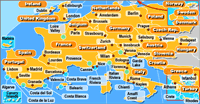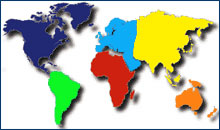Spitsbergen, Svalbard
Spitsbergen is the northernmost inhabited place on Earth, the realm of polar bears, whales, mammoth glaciers, Arctic students, Russian miners, and an eclectic collection of (rather chilly) scientists from 40 countries
The Svalbard Archipelago lies deep within the Arctic, stretching between 74° and 81°N.
Its main island, Spitsbergen (sometimes spelled Spitzbergen) is the northernmost inhabited place on Earth, lying some 1,151 km (715 miles) north of the Norwegian coast.
In fact, Svalbard is far closer to the North Pole (1,234km / 767 miles) than it is to Oslo (2,122km / 1,319 miles), the capital of Norway, of which these Arctic islands are technically a part.
Arctic ice, Arctic tundra
This is the Land of the Midnight Sun, with 24 hours of sunshine in the summer months (and temperatures that hover in the high 30s/low 40s).
Sixty percent of Svalbard is covered by glacial ice, including the largest glacier in Europe, the Austfonna on Nordauslandet Island.
The retreat of the ice
Yes, 60% of Svalbard is currently covered by ice year-round—but for how long?
On the west coast of Svalbard, the glaciers are retreating at the rate of nearly 100 feet per year—and Svalbard is just the most visible victim of the great Arctic melt.
True, some of the ice melts in the summer and freezes back again in the winter naturally all across the Arctic. The problem is that global climate change has pushed the cycle out of balance. Every year, more and more ice melts—and less and less returns in ever thinner ice sheets.
According to the Arctic Council, average temperatures in the Arctic have risen at almost twice the rate as the rest of the world over the past few decades.
In 2007, the Arctic melt broke all records, with 463,322 square miles of ice simply vanishing. That's an area bigger than Texas and California combined. If we keep this up, sometime in the next 20 to 50 years, the Arctic will be completely ice-free in the summertime.
This is not just an inconvenience (by which I mean "near-certain extinction") for polar bears, who already have a rough time hunting on the thinning pancake ice (they can lose up to half their body weight during the summer).
Let's put it this way:
• If all the glaciers in the Alps melt, global sea levels would rise by less than 1mm.
• If all of the rest of the sub-Arctic glaciers (beside Greenland) melt, the seas will rise about 1.5 feet.
• If Greenland melts, the sea levels will rise 20 feet.
• If all the ice in the Arctic melts, global sea levels will rise 197 feet.
To put that in perspective: I live in a landlocked state—Pennsylvania—some 80 miles from the nearest ocean. My house is roughly 184 feet above sea level.
I hope everyone, like me, who lives anywhere in or near a coastal area really, really likes to swim.
Or, you know, we could change our pollutin' ways. Just saying.
In fact, depending on how you parse the numbers (surface area versus volume, whether two ice caps that run together count as a single ice field, etc.), Austfonna is either the seventh largest in the world or, when teamed with neighboring Vestfonna, the world's third largest glacier (after the Antarctic and Greenland ice caps).
But of the 40% of Svalbard not entombed in ice year-round, you'll find a surprisingly lush tundra landscape.
This springy, squishy land is speckled with more than 160 species of flower, from the papery Svalbard poppy to tangy mountain sorrel to the "compass rose," a broad plug of moss campion that sprouts pink flowers starting on its southern face, which served early explorers as a rude compass.
There are also white puffballs of Arctic Cotton Grass, one-inch-tall "Polar Willow" solex trees, and clumps of purple saxifrage, which ranks as the northernmost flower that grows anywhere in the world (not here; on coastal Greenland).
The human population on Spitsbergen
A few tiny scientific and mining stations aside, there are really only three communities: the "capital" hamlet of Longyearbyen, the Russian-Ukrainian mining town of Barentsburg, and the spare international research station of Ny-Ålesund at 79° N.
Between them, Spitsbergen lays title to having the world's northernmost: university, bank, kebab stand, church, school, movie theater, museum, statue of Lenin, restaurant, train, hotel, and bar (in which Ukrainian miners will happily help you get drunk on vodka and Polar Bear beer after the homespun cultural show in the local auditorium).
Spitsbergen is also home to the Global Seed Vault, preserving the planet's biodiversity for future generations in tunnels bored into the 600-foot-thick permafrost, as well as to the fictional realm of the talking armored bears from The Golden Compass.
Spitsbergen wildlife
While the real ones may not talk (or wear armor), Svalbard does have more polar bears (3,000 to 4,000) than people (figures vary wildly—and the population swells in summer and shrinks in winter—but lies somewhere between 1,900 and 2,800).

A day hike above Longyearbyen.The polar bears are also why everyone in Spitsbergen carries a rifle everywhere they go—and why the bank in Longyearbyen might be the only bank in the world where most of the people who show up wearing ski masks and carrying a gun are just there to make a deposit.
Spitsbergen is a place where, on a typical cruise, you are likely to see herds of Svalbard Reindeer traipsing across the Arctic tundra, families of Arctic fox kits playing around the buildings of a scientific research station, great flocks of lesser auks keening around cliff tops, glaciers calving into the Arctic Ocean, 19th century trapper's huts and polar expedition staging grounds, and—I swear—polar bears feasting atop floating whales (if you're really, really, lucky—see the pictures at the end of this page).
Sailing off the edge of the map
It's also the only place on the planet where, thanks to the very tail end of the warming Gulf Stream currents—if wind conditions are favorable and the pack ice has been blown back—you can actually sail across the 80th parallel, right off the edge of the map.
For more info:
www.svalbard.net - Official tourism site
www.sysselmannen.no - Local government site
www.svalbard.com - Useful private siteAnd what do you find off the edge of the map? Here be monsters. Dozens of roaring walruses pile on the beaches of tiny Moffen Island, which lies just across the parallel—right after the blip of your ship has sailed north of the map and beyond the range of the modern GPS screen that shows the ship's progress.
Welcome to the northernmost edge of the world.
How to get to Spitzbergen
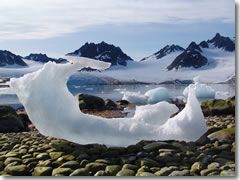
An eroded iceberg on a pebble beach on the Magdalenefjorden (Gully Glacier in background) in Spitsbergen, Svalbard, Norway.Most cruise companies can set up a full package for you, but to go it alone, first you have to get to Oslo (follow my standard procedure for getting the cheapest airfares). Expect this airfare to Oslo to cost, in summer, anywhere from $700 to $1,200 from New York–Newark, more if connecting via anywhere else.
From Oslo, there is one morning SAS-Scandinavian flight daily to Spitsbergen Airport (which search engines like to call "Longyearbyen, Svalbard;" the airport code is LYR).
The flight takes 4 hours (with a stop in Tromsø) and generally costs $450–$550, all taxes and fees included.
Yes, that is a polar bear eating a floating fin whale
A radio interview about Svalbard
On Jan. 24, I had the pleasure of sitting in for Arthur Frommer and co-hosting radio's "The Travel Show" with Pauline Frommer. At the top of the second hour, before returning to answering questions, I got to wax rhapsodic about Spitzbergen for about ten minutes. You can listen to the episode by clicking here and scrolling down to "The Travel Show, Hour 2, January 24, 2010."
During my week in Spitzbergen, I caught only one glimpse of a polar bear—just for a few seconds as he clambered out of the water on the far side of a fjord. (I later proceeded to swim, in my skivvies, in the same fjord, pushing past an iceberg on my way back to shore, making it a true polar bear swim and earning me muy macho points. There's a picture of it in the slideshow.)
However, the expedition leader on my cruise—an affable German named Heiko Kühr whom I got to know over beers in the onboard bar—was kind enough to send along the following photographs, which show what the cruise passengers saw exactly one week later in the exact same spot. I think he did this just to rub it in.
Goes to show: what you get to see really is just the luck of the draw.
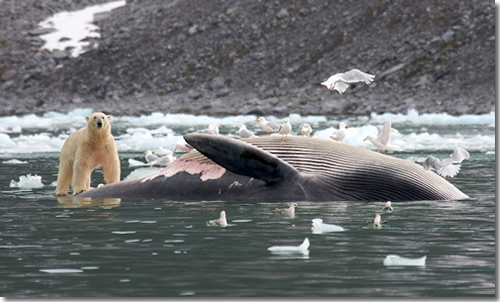
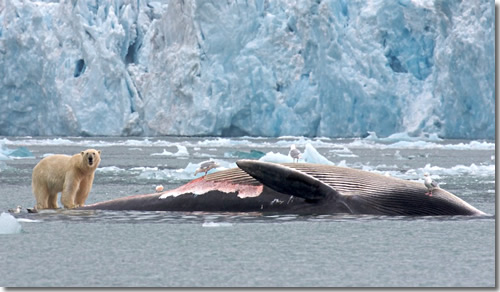
Yes, that is a polar bear eating a fin whale in a fjord on Spitsbergen, Svalbard, Norway. (Photo courtesy of Heiko Kuehr; www.heikokuehr.com.)
Related Articles |
Outside Resources |
This article was last updated in January 2010. All information was accurate at the time.
Copyright © 1998–2010 by Reid Bramblett. Author: Reid Bramblett.




 ShareThis
ShareThis
